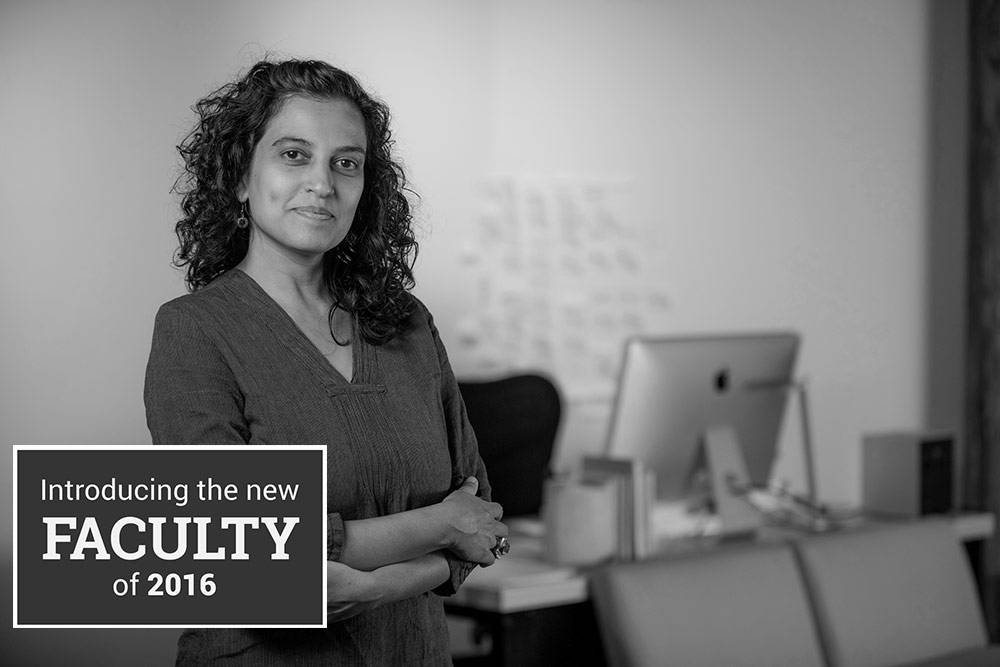Shambhavi Kaul: Bringing Backgrounds to the Foreground
New Moving Image faculty member is already a familiar face at Duke

The 11-minute film “Night Noon” spotlights a desert landscape that should be vaguely familiar to plenty of movie fans.
It served as the backdrop for scenes in Star Wars and dozens of other movies. But in Shambhavi Kaul’s short film, the stretch of barren America along Death Valley National Park is the main character -- without any droids or Stormtroopers trailing footprints in the sand.
Kaul’s practice that is grounded in cinema nevertheless includes film, video, photography, installation and writing. Much of her work focuses on sites: mountains, deserts, oceans but also manmade sites like film sets and airplane interiors. These sites she believes are too often relegated to the background.
“The site itself tends to be taken as a backdrop and we often take it for granted,” Kaul says. “But it is charged with meaning and therefore worth considering.”
A video clip of Death Valley from "High Noon" by Shambhavi Kaul.
Kaul is the newest faculty hire in Duke’s department of Art, Art History and Visual Studies. But really, she isn’t new at all, having taught film courses through the Program in the Arts of the Moving Image (AMI) since arriving at Duke as a visiting artist in 2009.
After years splitting time between part-time lecturing and a successful career as an international experimental filmmaker and artist -- showcasing her work at scores of major film festival like in Toronto, Berlin, London and New York -- Kaul has moved into a full-time faculty position as an assistant professor of the practice.
It is a role she’s embracing, moving her home studio to her new working space at Smith Warehouse and digging into faculty issues.
“I really do feel like a new faculty member. Here in my studio at Smith Warehouse my art practice and teaching are integrated and this is very satisfying,” she said.
Kaul is teaching two courses now, a capstone class through AMI and a documentary fieldwork class through Duke’s Master’s of Fine Arts in Experimental and Documentary Arts program. She’ll eventually teach courses in the art department’s popular visual and media studies program, which now boasts close to 40 majors and caters to entrepreneurial students with a range of interests and experiences.
“As a teacher, she brings a combination of perspectives in the classroom – mentoring students in ethnography, fieldwork, aesthetic commitment and personal expression,” said Thomas Rankin, who, as head of Duke’s Master of Fine Arts in Experimental and Documentary Arts program, has worked closely with Kaul. “Her international experiences ground so much of her thinking, urging the artists she teaches to dig deeply into the familiar, the local, while also challenging them to consider work and ideas from many other geographies.”
Kaul was raised in India, the daughter of Indian filmmaker Mani Kaul, an influential filmmaker of the 1970s and ‘80s.
“I grew up immersed in cinema,” she says.
She describes her educational career as “experimental,” beginning at a Krishnamurti school in India, to one of the last remaining Bauhaus colleges in the world to her graduate studies in New York at Bard College which patterns its MFA program after the North Carolina-based Black Mountain College, a forerunner in experimental arts education.
“Interdisciplinarity and learning inside and outside the classroom come naturally to me,” she said. “One of the most rewarding aspects of my new job is to bring this perspective to the pedagogical environment at Duke.
With the support of Sheila Dillon, her department chairwoman, Kaul recently converted an underused hallway space outside her studio into a space for art installation and by extension, the kind of learning she hopes to foster.
“Duke already has a focus on dynamic modes of learning so it is pleasing to be able to further this within my own field,” she said.